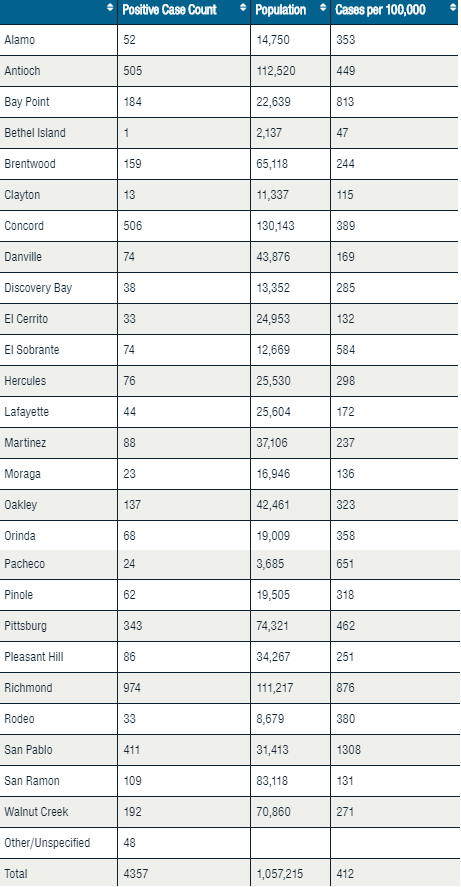
This is the COVID-19 daily update on Claycord.com:
-
- 1,286 active cases of COVID-19 in Contra Costa County.
- 105 new cases of COVID-19 in Contra Costa County since yesterday.
- 2,983 people have fully recovered from COVID-19 in Contra Costa County.
- 2 deaths since yesterday (both from long-term care facilities) (county total = 88).
- 62 of the 88 deaths were in long-term care facilities (2 more than yesterday)
- There are currently 13 outbreaks of COVID-19 at Contra Costa County long-term care facilities.
- Only 1 person under the age of 50 (they were in the 31-40 age group) has died from COVID-19 in Contra Costa County.
- 1,114 tests were conducted yesterday in Contra Costa County.
- 537 homeless people are currently placed in motel/hotel rooms in Contra Costa County. Placements are approved for homeless people who are awaiting COVID-19 test results or those who are considered at high risk.

PRIOR DAY CITY TOTALS:

The population in Contra Costa County is 1.1-million.


Is everyone in the hospital on a ventilator?
No. The first step is a nasal cannula. If that does not provide enough oxygen then they use an oxygen tent or oxygen mask. It seems the tents are more common with COVID-19 patients. Incubation is a literal last-gasp measure and likely means the person is also in the ICU.
Intubation, not incubation though I wish the latter was the case as it’s much more comfortable…
Stay safe out here in Contra Costa County. Lots of virus coming to town
Sad to see more deaths from the nursing facilities. The death rate for the 430 cases from those facilities is over 14%. For the rest of the confirmed cases, the death rate is 0.7%, less than 1 in a hundred.
But for folks over 60 the rate excluding the nursing home deaths is like 7%, or ten times the average.
Continue to be careful!
You might want to look for stats of deaths during summer in long term care facilities for past years. It’s been noted there are more deaths among the elderly in the summer than during the rest of the year. Remember “cases” don’t equate to “deaths”. Some of the people who are “cases” may not have any symptoms to be treated at all. Seems they shifted the emphasis (as many have noted) from deaths to cases maybe to scare the public more into submission?
@Captain Bebops. I have worked with the elderly in many different settings for over 10yrs. I have had countless hours of continued education along with personal research, in an array of topics concerning the elderly and their care. Not once have I been presented with statistics or case studies citing the increased mortality rate of the elderly in the summer months. In fact, the statics and case studies document the exact opposite. My own personal observations support these findings. The elderly have a higher mortality rate overall, in the months of Jan and Feb respectively, regardless of where they reside. I’d be curious as to where you obtained your evidence.
Folks…help me save the lives of our most vulnerable. Please wear a mask and social distance. I care about my clients and find value in their lives and contributions to ours. I beg you…please wear a mask
@Anon, probably conflicting research. One report I heard (as well as some articles that came up with a search) said summer but this one says winter. Still given California….
https://www.acsh.org/news/2019/07/10/more-people-die-winter-summer-14146
No matter where this virus originated, no matter what political, economic, social perspective: Never-maskers and never-distancers are now responsible for the continuing spread of this disease.
Where are the long term facilities at? What city in CCC?
@ Anonymous2
How naive of you. As if the solution was that simple.
You do realize we don’t live in an agrarian society where the next homestead is miles away and you only saw your neighbors on Sundays at Church. We are interdependent. That food, merchandise and services just don’t appear out of nowhere.
Shall we talk about the effectiveness of wearing masks and social distancing under the most ideal of circumstance – like a surgical theater and then discuss the effectiveness in real life as practiced by people in their day to day lives?
Masks and social distancing is nothing but a stop gap measure at best and was never intended to stop the spread of the disease. It was only intended to slow the spread of the disease but live your life in hole if you’d like.
I assume you know the “experts” now think the virus might be airborne? If so, masks and social distancing is a useless measure meant to make people like you feel better and frankly superior.
Thank you WC Resident for your response
Janus, can you clarify your reasoning as to how an airborne virus (that is spread through respiratory particles) would not be prevented by masks that help people keep their respiratory particles to themselves?
Airborne transmission means the pathogen is attached to very tiny particles, such as dust, which can carry it on air currents. Covid 19 had been found to be carried in respiratory droplets, which are larger and fall out of the air relatively quickly. It’s not the same as airborne.
First off, don’t confuse waterborne with airborne. They are two totally different avenues of infection.
Right now as I understand it, the virus is thought to be spread predominately through water droplets from breathing, sneezing or coughing (waterborne) – Yes there are other ways but mostly through the byproduct of breathing.
If however, the virus is found to be airborne, it is not only suspended in water droplets (waterborne) but it is suspended in the air itself.
Unless you are wearing a respirator mask with a filter fine enough to trap the size of Covid-19, which is around 0.125 microns or a containment suit with it’s own supply of oxygen you will at some-point be exposed if you breath air.
Think of it like this. When you smell something cooking on the stove, you have ingested it. How? Partials of the food have become airborne… now think about flatulence.
@Buck – Transmission from one person to another via respiratory droplets vs. an airborne disease is two different things. A basic cloth mask can capture respiratory droplets.
The primary transmission vector for SARS-CoV-2/COVID-19 is respiratory droplets which is why masks and one to two meter social distancing has been recommended by health authorities worldwide. A secondary vector is bodily fluids which is why hand washing and hand sanitizers are recommended health authorities though I don’t know if that’s a worldwide recommendation.
Measles and Chickenpox are examples of airborne diseases where masks are not as effective.
What has happened recently is a report that COVID-19 may also be transmitted via aerosols, like an airborne disease, at times. They are suggesting that COVID-19 guidance published by the WHO and health authorities be updated to take this into account. It would be a third vector. Some studies of COVID-19 transmission have included observations of the ventilation rate or air exchange rate of the areas or spaces where transmission from one person to another has been believed to occur. If you are in a small enclosed place with someone the odds of transmission go up. If you are outdoors the odds go down. That’s what lead people to write the report that COVID-19 may have an aerosol transmission vector.
While aerosol transmission may be a vector I believe it’s a very small one. If it were a significant vector then essential workers would be catching COVID-19 at a much higher rates and COVID-19 would be growing much faster through communities.
Respiratory droplets is still the primary transmission vector. Don’t throw those masks out yet. Bodily fluids also seems to be a significant vector and so continue to be mindful of contact and hand washing. To account for the potential of transmission via aerosols I would refrain from entering small enclosed spaces that are used by the public for extended periods of time. Elevators and BART train cars are an example of this.
I went to Sun Valley Mall yesterday and was appalled at how many (mostly young people) either did not wear a mask at all, or had pushed them down exposing their noses and in some cases their mouths, or had the mask dangling from one ear. Having a mask in the vicinity of your mouth and nose does nothing! Come on people, wearing a mask is such a small thing to help keep old codgers like myself alive and kicking!
I had the same experience at Lafayette Reservoir on Sunday. A lot of people just completely ignorant and show selfishness. It must to be mandatory for all of us now-just wear the mask outside or inside the business or stores Very simle rool for everyone!
Positive experience: My husband Jim, an architect, had to go to a job site in San Jose today to oversee water testing for leak repairs. It’s a large condominium complex. Jim (wearing a mask) didn’t have to get close to anyone. But he told me how confident it was to see all construction workers wearing masks. All homeowners walking thru common areas had masks on. He was reminded of how many things you touch in public … Hand rails going up stairs, doors, etc. So there are people who are trying hard to beat this bugger, and taking necessary and simple safety precautions.
Jim did say, though, that he feels like the TV character Monk, with his mask wearing and copious wiping down with Purrell wipes when in public. So glad we are both healthy! Mary
Claycord,
Thank you so much for keeping our community fully informed on Covid-19.
Does anyone know if our local hospitals have changed protocol now that we know so much more about the virus? Specifically, treatments like immediately giving Hydroxychloriquine, (sp), inhaled steroids, antibiotics, etc…..In addition, are they using CPAP machines in addition to a nose cannula? I’ve read where this virus causes blood clots throughout the body. Are they putting people on blood thinners? Lastly, are they allowing at least one family member to be with a critically ill patient?